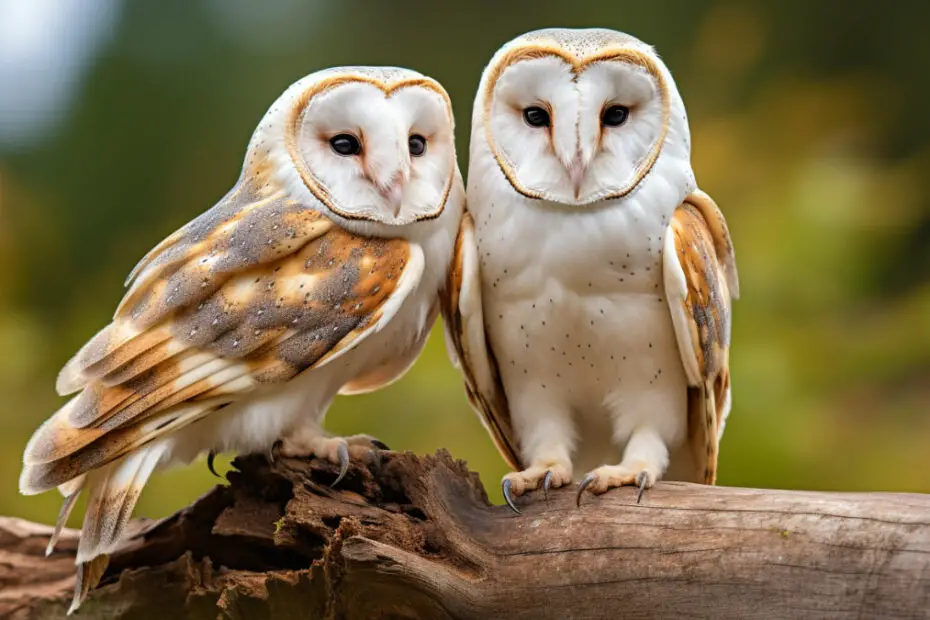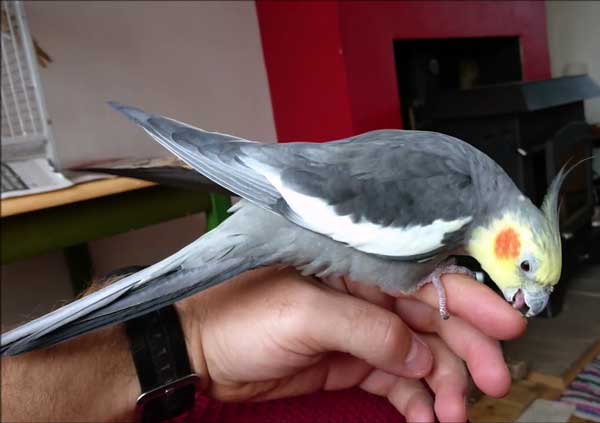Owls are known for their keen senses, particularly their remarkable ability to hunt in near darkness. While their iconic facial discs and large, expressive eyes are well known, many people wonder:
Do owls have ears? Yes, they do. However, unlike humans, who have visible external ears, owls’ ears are openings located on the sides of their heads. These openings are hidden beneath their feathers. The asymmetrical placement of their ears is also another key feature that sets them apart. This feature aids in pinpointing the source of sounds.
Continue reading to learn all about the hearing anatomy of an owl. I will also debunk some common myths about owls’ ears.
Do Owls Have Ears? Overview Of External And Internal Structure
Yes, owls have ears. Owls’ reliance on hearing is critical to their survival. In the dark, where vision is limited, owls rely on their acute hearing to locate prey and navigate their nocturnal environments.
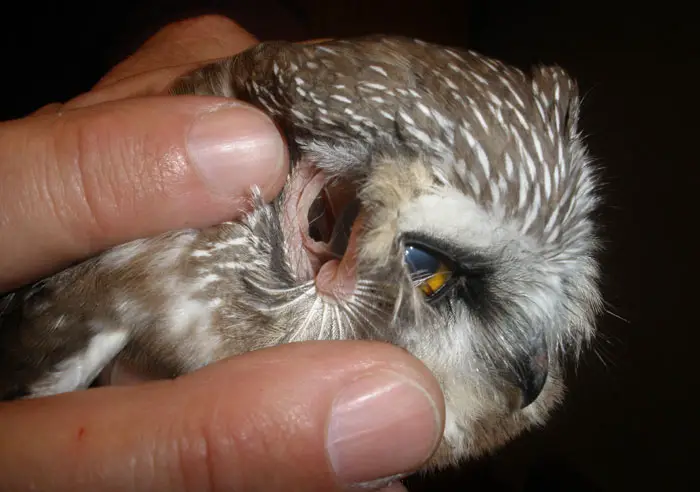
However, their ear structure is quite different from ours. They do not have external ear flaps or pinnae and their ears are not visible. Let’s look into the anatomical structure of owls’ ears.
External Structure
Owls have ear openings on each side of their head under their feathers. But the ear opening, also known as the aperture, differs between owl species. Some species have small circular openings with an operculum covering them. However, others have slit-like openings with or without an operculum.
An operculum is an aperture with a valve that serves as a protective cover for the ear opening. It prevents debris and foreign particles from interfering with the delicate auditory structures.
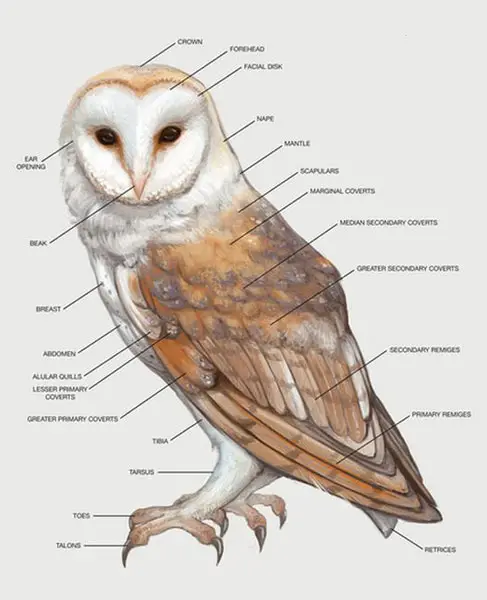
The variation in ear structure is especially noticeable in the Tytonidae and Stringdae families. The Tytonidae family has rounded openings with an operculum, while Strigidae owls have a broader range of outer ear shapes. In all owl species, these openings are covered by feathers, which form the facial disc.
Another distinguishing feature is the asymmetrical positioning of the ear openings. This means that one ear is particularly higher than the other. This is especially noticeable in strictly nocturnal owls such as the Barn Owl or the Tengmalm’s (Boreal) Owl.
Internal Structure
The only similarity between owl ears and human ears is the internal structure. The owl’s ear is also divided into three sections: the cochlea, the vestibular system, and the auditory nerve.
- The cochlea is a spiral, snail-shaped structure that converts sound vibrations into signals the brain can interpret. It is filled with fluid and contains hair cells, which are the sensory receptors for hearing. The eardrum is also located in this part.
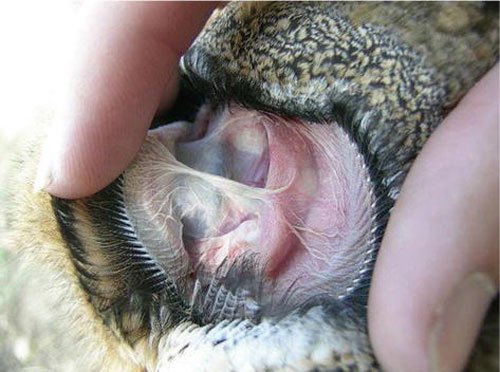
Notably, an owl’s eardrum is relatively larger compared to other avians. Owls have a well-developed cochlea that detects a broad range of frequencies. This includes high-pitched sounds that are produced by small mammals such as rodents.
- The vestibular system is crucial for maintaining the owl’s balance and coordination during flight and other activities. It consists of the utricle, saccule, and three semicircular canals.
- The auditory nerve connects the cochlea to the brain. It transmits signals generated by sound stimulation. Owls have a highly developed auditory nerve, which allows for rapid and efficient processing of information.
Adaptation Of An Owl’s Hearing
The auditory system of an owl is finely tuned to meet the unique challenges of nocturnal life. Here, you will look at the key elements that make up an owl’s hearing and their usefulness.

1. The Fascial Disc
The facial disk is a circular arrangement of feathers that forms a concave structure around the owl’s eyes. Consider cupping your hands around your ears to improve your hearing; the owl’s facial disc serves a similar function.
It directs sound waves towards the ear openings, allowing owls to hear even faint noises. The fascial disc also increases surface area, which increases the owl’s sound sensitivity by about 20 decibels.
The feathers within the facial disc are also movable and are adjusted by the owl’s facial muscles. This adaptability sharpens the owl’s ability to capture specific frequencies and accurately pinpoint sounds.
2. Operculum
Apart from protecting the delicate internal structures of the ear from debris, the operculum also provides an advantage during flight. It is movable and reduces turbulence noise during flight.

3. Asymmetrical Ears
The asymmetry of an owl’s ears allows it to capitalize on the minute time differences between each ear’s reception of a sound. This temporal difference is known as the interaural time difference. The difference is as little as 0.00003 seconds (30 millionths of a second).
This becomes the owl’s guiding beacon in determining the direction of the sound. For example, if the noise comes from the left, the left ear detects it slightly before the right ear.
The owl quickly turns its head to align both ears with the sound source. This allows it to pinpoint the location. Furthermore, the structural difference allows the owl to determine whether a sound is coming from above or below its line of sight.
If the source is below, the sound is perceived as louder in the right ear. This provides critical information about the vertical positioning of the prey. Note that the degree of asymmetry varies across owl species.
Certain species, such as the Northern Saw-Whet owl, have significant differences in ear placement. This results in a distinct and visually striking asymmetry.
4. Sound Location Memory
When an owl hears a sound, it creates a detailed map in its brain. It precisely notes the sound source about its position and can recall it later. The owl’s brain controls this one-of-a-kind ability.
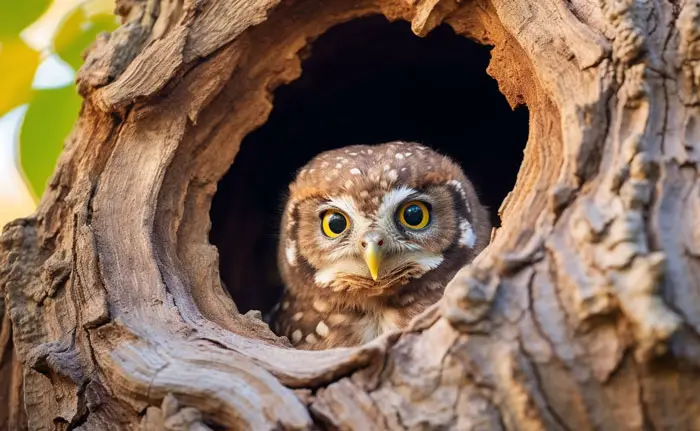
In comparison to other birds, owl medullas are extremely complex. A barn owl’s medulla, for example, has an estimated 95,000 neurons. This improves triangulation, or the ability to precisely pinpoint sound sources.
Triangulation occurs when the owl turns its head at an angle and the sound hits both ears at the same time. Once triangulation occurs, the brain cells create an internal map of the sound’s direction. The owl will remember the location and fly in that direction until it reaches its prey.
5. The Beak
The beak is an often-overlooked contributor to an owl’s auditory adaptations. The downward-pointing beak increases the surface area over which the facial disc collects sound waves.
This improves the efficiency of sound capture, increasing the owl’s ability to detect and locate prey even in the quietest of environments.
Here is a video expounding on the above section.
What Are Ear Tufts?
Ear tufts are also known as “plumicorns” or “feathered tufts”. They are distinctive feathered structures found on the heads of some owl species. One common misconception is that these tufts serve as actual ears. However, as we have established, an owl’s true ears are located on the sides of its head.
Therefore, despite their name, these tufts are not directly associated with the owl’s ears. They play a role in communication, helping convey mood or intention to other owls. They also serve a camouflaging function as they resemble branches or additional plumage.
This aids in concealment during the day. Ear tufts are not found in all owl species, and their size, shape, and placement can vary.

FAQs
Here are other related questions about an owl’s hearing.
Owls are distinguished by their ability to fly nearly silently through the night. This effect is achieved through the use of specialized feathers and wing structures that reduce turbulence and aerodynamic noise.
The near-silent approach allows owls to close in on prey without alerting them. Also, their silent flight allows them to focus solely on detecting even the faintest sounds emitted by potential prey.
Owls have extraordinary hearing abilities that far surpass those of humans. Their hearing range is approximately 200 Hz to 12 kHz. This encompasses a wide range of sounds. This means that an owl may hear up to ten different notes, whereas humans hear only one sound.
While the exact distance varies by species, most owls can hear up to 10 miles away. This exceptional hearing range aids their hunting efficiency by allowing them to locate potential prey or detect the calls of other owls.
Conclusion
So, do owls have ears? Yes, their ears are concealed under their facial feathers. Unlike human ears, owl ears are openings that are strategically placed on the sides of their heads. Some owls have operculum covering their ears while others don’t.
The facial disc guides sound into the ear openings, while asymmetrical ears enable precise sound localization. Owls’ ears serve as a reminder that even in the dark, nature has provided its inhabitants with the tools they require to thrive.
